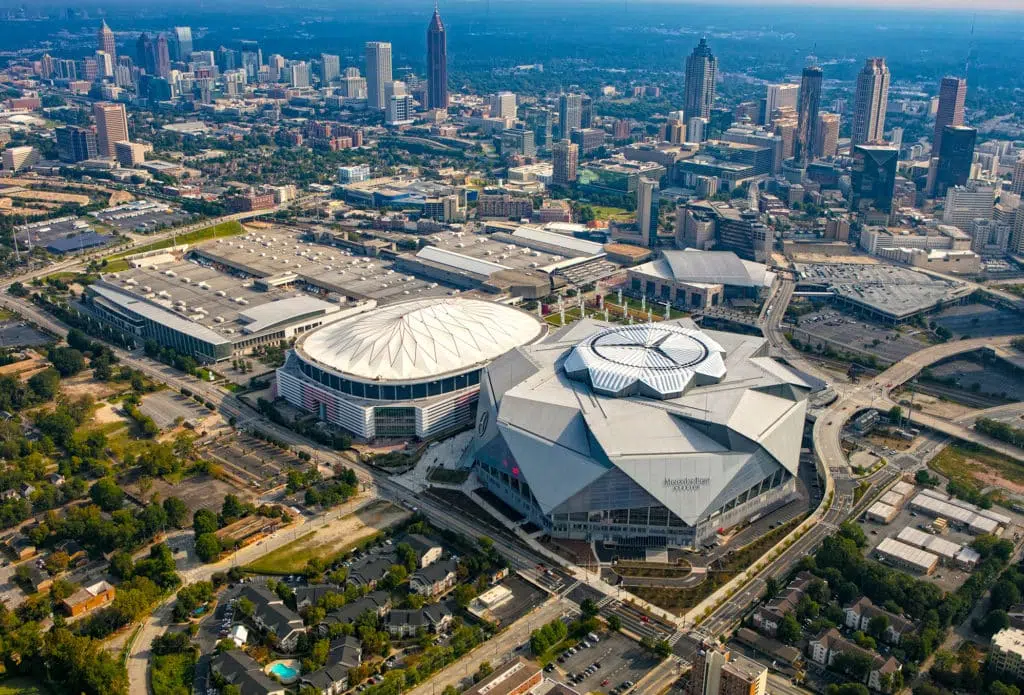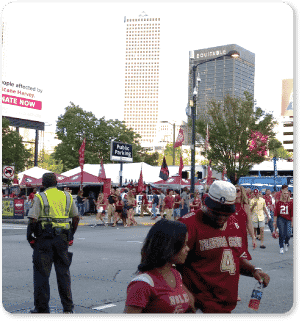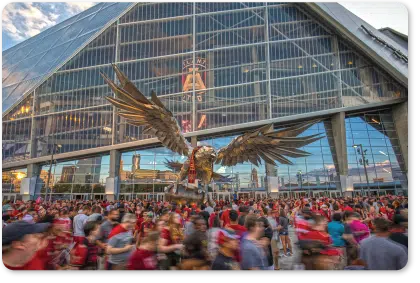- January 17, 2019
- Kimley-Horn Corner, Perspectives
Game-Changing Approaches to Special Event Management
- By: Sean Coleman


Sean Coleman, P.E., PTOE
Atlanta, Georgia
After a football game in late 2017, it took approximately 60 minutes to clear more than 70,000 guests from the parking decks and streets around the arena. Only a year earlier, it had taken twice that amount of time. What was responsible for the change? At the Institute of Transportation Engineers (ITE) Annual Meeting in Minneapolis, Kimley-Horn’s Sean Coleman, PE, PTOE explained how rethinking game-day traffic operations can be a game-changer. Read on to learn Sean’s best approaches to special event management.
Mercedes-Benz Stadium (MBS), Georgia World Congress Center (GWCC), and State Farm Arena (formally Phillips Arena) are popular locations for special events in Atlanta, GA. These venues host the Atlanta Falcons and Hawks as well as the Atlanta United, which is an expansion Major League Soccer (MLS) club that has broken every MLS attendance record in only two years. Though the venues are near one another, prior to 2017, each venue had its own game day operations plan. There was minimal coordination among the event spaces, little use of signal timing, and limited discussion among the multiple public agencies involved in the permitting process.
For better collaboration among these venues, Kimley-Horn partnered with GDOT, Renew Atlanta, Central Atlanta Progress, GWCC, MBS, and State Farm Arena to create the Downtown Atlanta Special Events Playbook—a single source for the management of special events throughout Downtown Atlanta. Police Chief Paul Guerrucci, Director of Public Safety at the Georgia World Congress Center Authority, lauded the collaborative efforts, calling the Playbook a “model for other venues to emulate,” due to its ability to “manage traffic for the betterment of the customer experience while simultaneously reducing the impact on surrounding neighborhoods.” The resource includes guidelines for monitoring personnel and provides coordination requirements based on total attendance size, including guidance for when multiple venues are activated at the same time. In addition, the Playbook discusses how to partner with officers and ride-sharing/navigation companies, implement signal/ITS upgrades, create a traffic plan, develop an implementation and review process, and implement signal timing for a special event.
 To control intersections, we partnered with GWCC and the Atlanta Police Department to develop traffic signal timing that enhances the officer-led traffic control. Officers from these groups understand how drivers and pedestrians behave, and with their input and mutual trust, we developed a successful plan informed by their experiences. The plan allows officers to focus on vehicular and pedestrian safety—including separating pedestrians from traffic—and on restricting vehicles from “blocking the box.” Before the Playbook was implemented, officer-led traffic control involved setting over 50 downtown intersections in flash, with officers working traffic control at each intersection. Now that our signal timing work is controlling intersections, officer safety has been enhanced and staffing needs reduced, allowing officers to be placed in locations more strategically and efficiently.
To control intersections, we partnered with GWCC and the Atlanta Police Department to develop traffic signal timing that enhances the officer-led traffic control. Officers from these groups understand how drivers and pedestrians behave, and with their input and mutual trust, we developed a successful plan informed by their experiences. The plan allows officers to focus on vehicular and pedestrian safety—including separating pedestrians from traffic—and on restricting vehicles from “blocking the box.” Before the Playbook was implemented, officer-led traffic control involved setting over 50 downtown intersections in flash, with officers working traffic control at each intersection. Now that our signal timing work is controlling intersections, officer safety has been enhanced and staffing needs reduced, allowing officers to be placed in locations more strategically and efficiently.
 Kimley-Horn’s work managing game day operations for football, basketball, and soccer led to the opportunity to successfully manage the 2018 College Football National Championship. Despite several unexpected changes—like finding out a few days before the game that President Trump planned to attend—our client at GDOT said we “prepared and executed an excellent traffic operations plan.” This work led our team to be selected to provide transportation planning services for the big game at Mercedes-Benz Stadium in February 2019. Kimley-Horn’s Rob Ross and Liz Johnson are coordinating this effort, connecting more than 40 agencies to create a comprehensive plan. By coordinating collaborative environments, Kimley-Horn has entered into strong partnerships, creating and implementing game-changing plans, with more wins in sight.
Kimley-Horn’s work managing game day operations for football, basketball, and soccer led to the opportunity to successfully manage the 2018 College Football National Championship. Despite several unexpected changes—like finding out a few days before the game that President Trump planned to attend—our client at GDOT said we “prepared and executed an excellent traffic operations plan.” This work led our team to be selected to provide transportation planning services for the big game at Mercedes-Benz Stadium in February 2019. Kimley-Horn’s Rob Ross and Liz Johnson are coordinating this effort, connecting more than 40 agencies to create a comprehensive plan. By coordinating collaborative environments, Kimley-Horn has entered into strong partnerships, creating and implementing game-changing plans, with more wins in sight.
Partner with Officers
 To control intersections, we partnered with GWCC and the Atlanta Police Department to develop traffic signal timing that enhances the officer-led traffic control. Officers from these groups understand how drivers and pedestrians behave, and with their input and mutual trust, we developed a successful plan informed by their experiences. The plan allows officers to focus on vehicular and pedestrian safety—including separating pedestrians from traffic—and on restricting vehicles from “blocking the box.” Before the Playbook was implemented, officer-led traffic control involved setting over 50 downtown intersections in flash, with officers working traffic control at each intersection. Now that our signal timing work is controlling intersections, officer safety has been enhanced and staffing needs reduced, allowing officers to be placed in locations more strategically and efficiently.
To control intersections, we partnered with GWCC and the Atlanta Police Department to develop traffic signal timing that enhances the officer-led traffic control. Officers from these groups understand how drivers and pedestrians behave, and with their input and mutual trust, we developed a successful plan informed by their experiences. The plan allows officers to focus on vehicular and pedestrian safety—including separating pedestrians from traffic—and on restricting vehicles from “blocking the box.” Before the Playbook was implemented, officer-led traffic control involved setting over 50 downtown intersections in flash, with officers working traffic control at each intersection. Now that our signal timing work is controlling intersections, officer safety has been enhanced and staffing needs reduced, allowing officers to be placed in locations more strategically and efficiently.
Partner with Ride-Sharing and Navigation Companies
Our team established partnerships with Lyft—MBS’s exclusive rideshare provider—and Waze—a GPS navigation system. With Lyft, we identified optimal locations for passenger drop-offs and pick-ups. Riders are directed to a specific pickup location, depending on where they exit the stadium when requesting a Lyft. We worked closely with the stadium and Lyft to develop this innovative approach, offering suggestions for rideshare locations, and adjusting them based on their feedback. With Waze, we partnered with the stadium to preprogram road closures and implement time-based restrictions on certain routes on game days. Since Lyft also uses Waze, we can control both vehicular and rideshare traffic, directing vehicles to our planned courses in coordination with the signal timing we developed.Implement Signal/ITS Upgrades
To systematically move vehicles and pedestrians in a coordinated way throughout the entire downtown network, we used optimized signal timing at more than 150 intersections throughout Downtown Atlanta. Additionally, GDOT improved traffic signal operations by upgrading firmware and providing 4G communication upgrades at these locations. More than 40 CCTVs were installed, 16 cabinets were upgraded, and five blank-out signs were added to enhance traffic control capabilities. Other additions included flashing yellow arrows and data collection and detection devices.Create a Traffic Plan
By adding technical advancements and new traffic control approaches, we worked with GWCC to update the traffic plan they’d been using for years. For instance, GWCC had previously contraflowed three corridors on game days. We removed one of these corridors and replaced it with signal timing, which minimized staffing needs and allowed resources to be reassigned. Other improvements included implementing road closures and turn restrictions to control traffic flow. These approaches would be in vain without intentional coordination to implement the plan, adjust based on stakeholder input, and maintain partnerships. We review this plan in weekly committee meetings, and through efforts led by Kimley-Horn’s Mike Blanchette and Lance Ballard, we are continuously collaborating with stakeholders to enhance the signal timing and improve the traffic plan.Implement Signal Timing
Our team developed several signal timing plans for the ingress and egress periods for multiple events, based on location (MBS vs. State Farm Arena) and size (70,000 fans vs 15,000 fans). The timing plans are operated for each event out of GDOT’s Traffic Management Center. These plans include several innovative signal timing techniques, including rest in green flush plans, vehicular and pedestrian pulse plans, and pedestrian scrambles by time-of-day. The pedestrian scrambles are particularly effective in areas that experience heavy pedestrian volumes during the events. They also allow vehicles to move through these intersections without pedestrian conflicts. At the intersection of Northside Drive at Carter Street, a pedestrian scramble pulse is implemented to move thousands of pedestrians across a busy state arterial route to a MARTA transit station opposite the stadium. This intersection would have taken half a dozen officers to manage the crowd prior to utilizing signal timing, and now it can be managed by two officers working in tandem with the traffic signal timing plans.What’s Next?
 Kimley-Horn’s work managing game day operations for football, basketball, and soccer led to the opportunity to successfully manage the 2018 College Football National Championship. Despite several unexpected changes—like finding out a few days before the game that President Trump planned to attend—our client at GDOT said we “prepared and executed an excellent traffic operations plan.” This work led our team to be selected to provide transportation planning services for the big game at Mercedes-Benz Stadium in February 2019. Kimley-Horn’s Rob Ross and Liz Johnson are coordinating this effort, connecting more than 40 agencies to create a comprehensive plan. By coordinating collaborative environments, Kimley-Horn has entered into strong partnerships, creating and implementing game-changing plans, with more wins in sight.
Kimley-Horn’s work managing game day operations for football, basketball, and soccer led to the opportunity to successfully manage the 2018 College Football National Championship. Despite several unexpected changes—like finding out a few days before the game that President Trump planned to attend—our client at GDOT said we “prepared and executed an excellent traffic operations plan.” This work led our team to be selected to provide transportation planning services for the big game at Mercedes-Benz Stadium in February 2019. Kimley-Horn’s Rob Ross and Liz Johnson are coordinating this effort, connecting more than 40 agencies to create a comprehensive plan. By coordinating collaborative environments, Kimley-Horn has entered into strong partnerships, creating and implementing game-changing plans, with more wins in sight. 